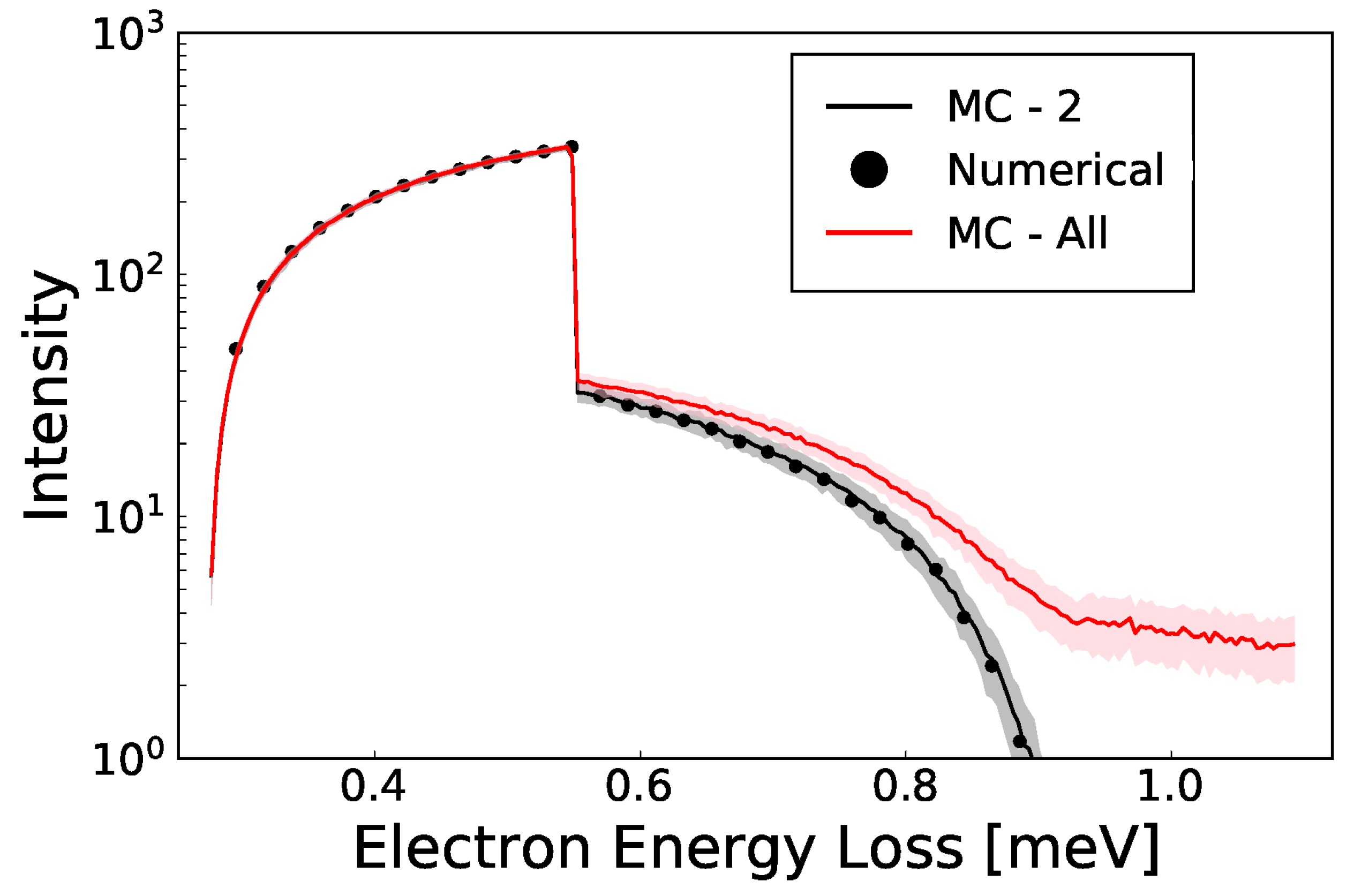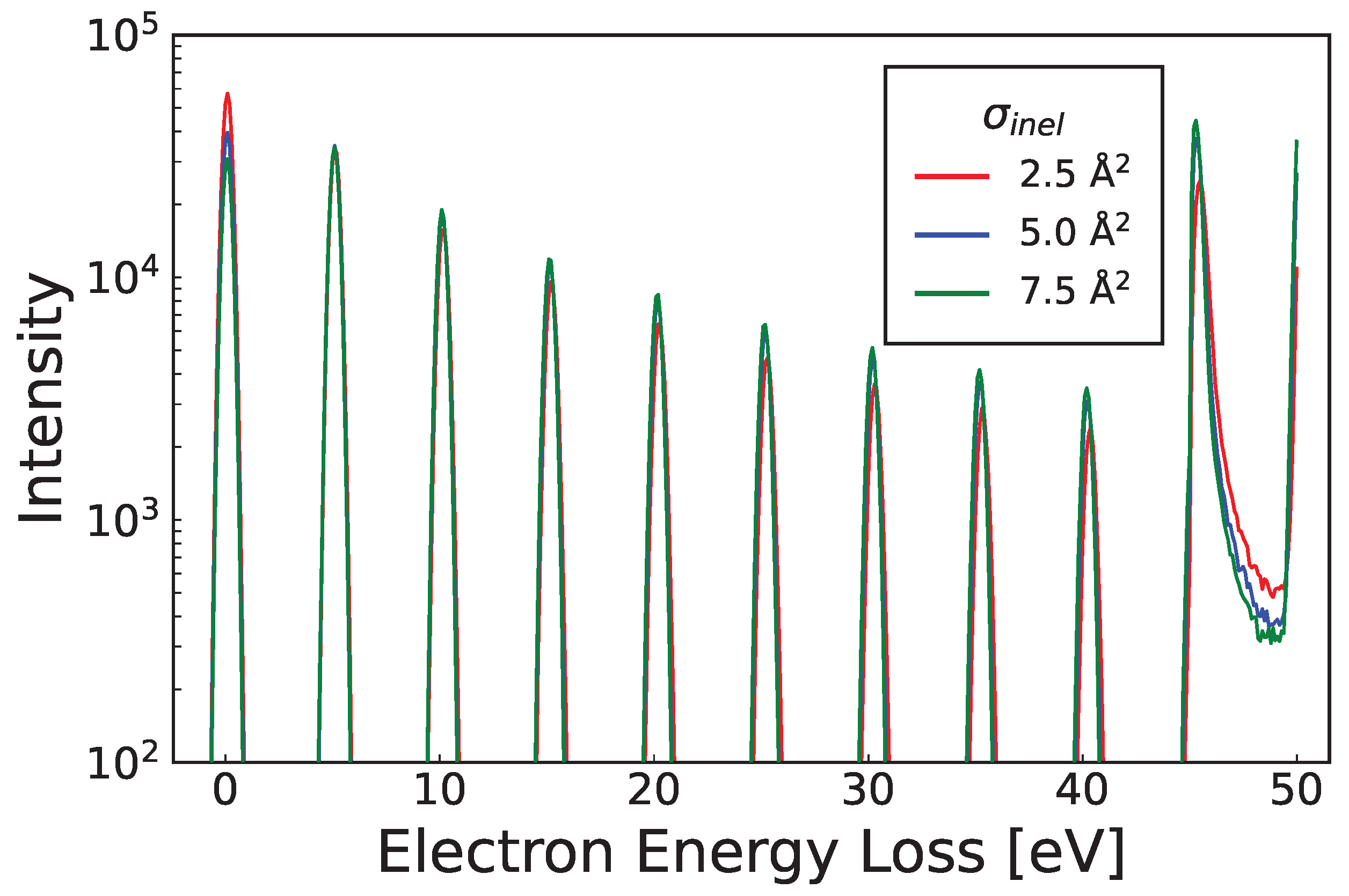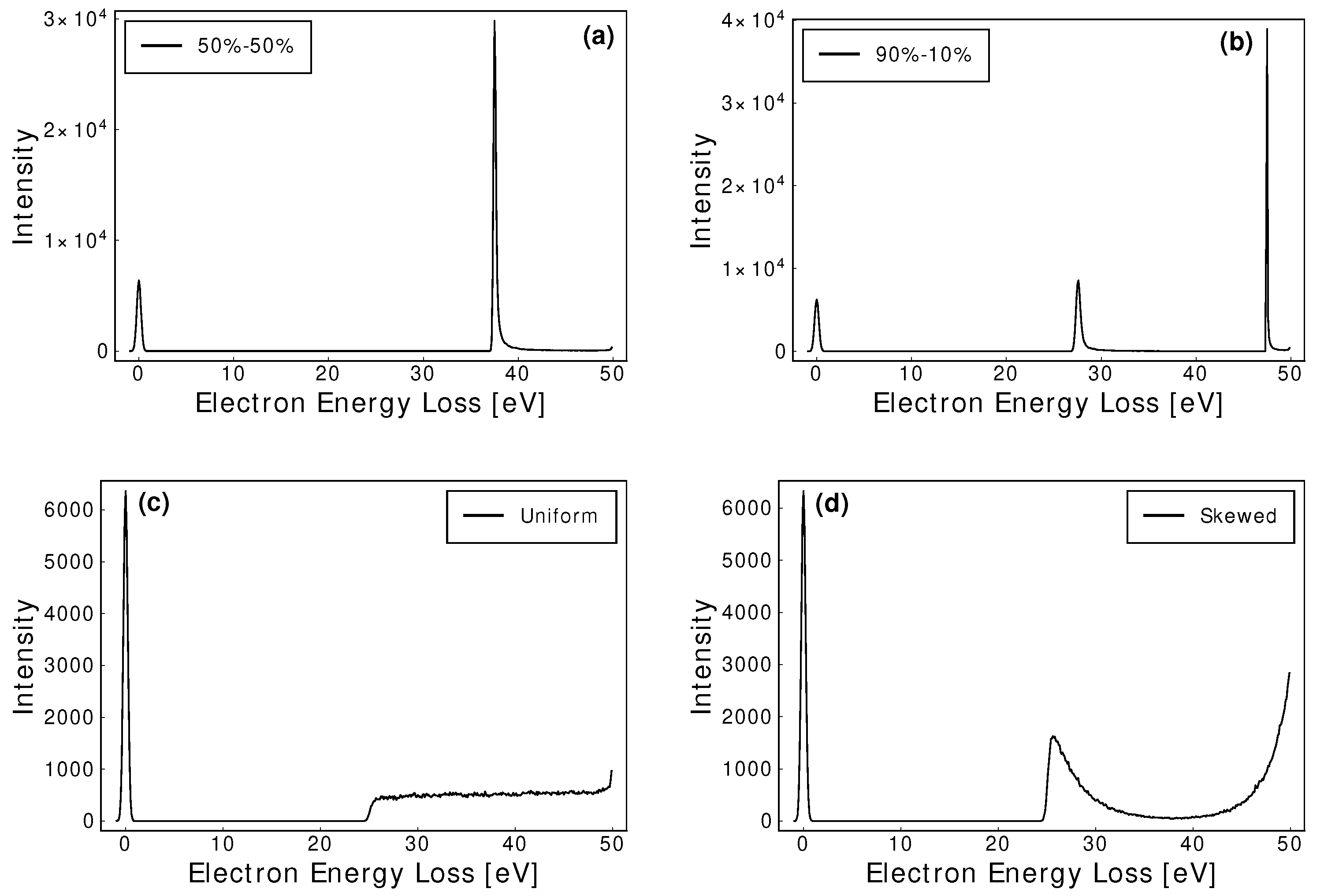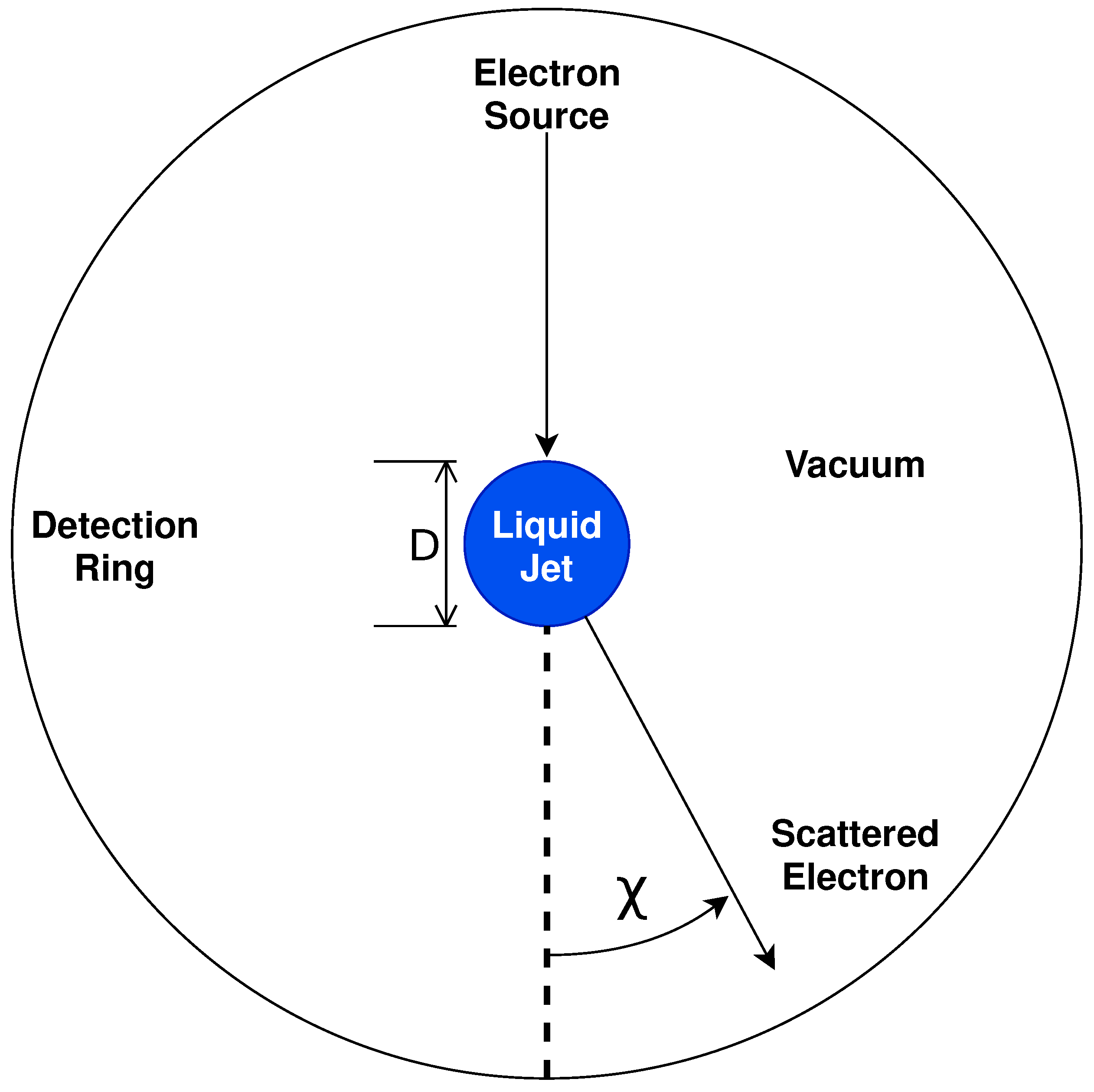Simulating the Feasibility of Using Liquid Micro-Jets for Determining Electron–Liquid Scattering Cross-Sections
Abstract
:1. Introduction
2. The Proposed Electron–Liquid Micro-Jet Scattering Experiment
2.1. Liquid Micro-Jets
2.2. Crossed-Beam Electron Scattering from Liquid Micro-Jets
2.3. Extraction of Cross-Section Sets from EELS
3. Simulation of Electron Transport through Liquid Micro-Jets
3.1. Liquid Dynamics
3.2. Interfacial Dynamics
3.3. Experimental Parameters
3.4. Liquid Micro-Jet Parameters
4. Determining Cross-Sections from Electron Energy Loss Spectra Using Machine Learning
4.1. Machine Learning Methodology
4.2. Cross-Section Regression Given the EELS
5. Conclusions
Author Contributions
Funding
Institutional Review Board Statement
Informed Consent Statement
Acknowledgments
Conflicts of Interest
Appendix A. Benchmarking of the Liquid Micro-Jet Simulation
Appendix A.1. Swarm Benchmarks
| F | W | ||||
|---|---|---|---|---|---|
| 0 | [98] | 5.565 | 7.319 | 27.26 | 26.54 |
| Current | 5.563 | 7.327 | 27.28 | 26.64 | |
| Uncertainty | 0.0001 | 0.003 | 0.03 | 0.04 | |
| 0.5 | [98] | 5.224 | 8.593 | 27.26 | 28.65 |
| Current | 5.223 | 8.594 | 27.23 | 28.62 | |
| Uncertainty | 0.001 | 0.005 | 0.04 | 0.07 | |
| 1 | [98] | 4.969 | 9.474 | 27.23 | 29.33 |
| Current | 4.968 | 9.487 | 27.25 | 29.42 | |
| Uncertainty | 0.002 | 0.008 | 0.05 | 0.01 |
| W | |||||
|---|---|---|---|---|---|
| 0 | [98] | 0.833 | 1.385 | 2.38 | |
| Current | 0.834 | 1.384 | 2.825 | 2.38 | |
| Uncertainty | 0.0001 | 0.001 | 0.017 | 0.02 | |
| 0.2 | [98] | 0.976 | 3.397 | 6.32 | |
| Current | 0.977 | 3.388 | 9.09 | 6.35 | |
| Uncertainty | 0.0001 | 0.003 | 0.04 | 0.05 | |
| 0.3 | [98] | 1.080 | 5.929 | 11.2 | |
| Current | 1.080 | 5.915 | 17.92 | 11.1 | |
| Uncertainty | 0.0001 | 0.001 | 0.009 | 0.01 | |
| 0.4 | [98] | 1.233 | 10.52 | 19.51 | |
| Current | 1.234 | 10.50 | 34.97 | 19.51 | |
| Uncertainty | 0.0001 | 0.004 | 0.013 | 0.013 |
Appendix A.2. Beam Benchmark

Appendix B. Electron Energy Loss Spectra: Sensitivity to the Scattering Dynamics and Experimental Parameters
Appendix B.1. Magnitude and Energy Dependence of Elastic and Excitation Cross-Sections on the EELS
Appendix B.1.1. Effect of the Elastic Cross-Section Dependence on the EELS


Appendix B.1.2. Effect of the Excitation Cross-Section Dependence on the EELS


Appendix B.1.3. Effect of the Ionisation Cross-Section Dependence on the EELS

Appendix B.2. Anisotropy in the Scattering Dynamics
Appendix B.2.1. Coherent Scattering Effects

Appendix B.2.2. Differential Cross-Section Effects

References
- Shimizu, T.; Steffes, B.; Pompl, R.; Jamitzky, F.; Bunk, W.; Ramrath, K.; Georgi, M.; Stolz, W.; Schmidt, H.; Urayama, T.; et al. Characterization of microwave plasma torch for decontamination. Plasma Process. Polym. 2008, 5, 577–582. [Google Scholar] [CrossRef]
- Tanaka, H.; Mizuno, M.; Ishikawa, K.; Nakamura, K.; Kajiyama, H.; Kano, H.; Kikkawa, F.; Hori, M. Plasma-activated medium selectively kills glioblastoma brain tumor cells by down-regulating a survival signaling molecule, AKT kinase. Plasma Med. 2011, 1, 265–277. [Google Scholar] [CrossRef] [Green Version]
- Taylor, D.W.; Petrera, M.; Hendry, M.; Theodoropoulos, J.S. A systematic review of the use of platelet-rich plasma in sports medicine as a new treatment for tendon and ligament injuries. Clin. J. Sport Med. 2011, 21, 344–352. [Google Scholar] [CrossRef] [PubMed] [Green Version]
- Schlegel, J.; Köritzer, J.; Boxhammer, V. Plasma in cancer treatment. Clin. Plasma Med. 2013, 1, 2–7. [Google Scholar] [CrossRef]
- Keidar, M. Plasma for cancer treatment. Plasma Sources Sci. Technol. 2015, 24, 033001. [Google Scholar] [CrossRef]
- Bekeschus, S.; Schmidt, A.; Weltmann, K.; von Woedtke, T. The plasma jet kINPen—A powerful tool for wound healing. Clin. Plasma Med. 2016, 4, 19–28. [Google Scholar] [CrossRef]
- Bernhardt, T.; Semmler, M.L.; Schäfer, M.; Bekeschus, S.; Emmert, S.; Boeckmann, L. Plasma medicine: Applications of cold atmospheric pressure plasma in dermatology. Oxidative Med. Cell. Longev. 2019, 2019, 1–10. [Google Scholar] [CrossRef] [PubMed] [Green Version]
- von Woedtke, T.; Schmidt, A.; Bekeschus, S.; Wende, K.; Weltmann, K. Plasma medicine: A field of applied redox biology. In Vivo 2019, 33, 1011–1026. [Google Scholar] [CrossRef] [PubMed] [Green Version]
- Liu, D.; Szili, E.J.; Ostrikov, K. Plasma medicine: Opportunities for nanotechnology in a digital age. Plasma Process. Polym. 2020, 17, 2000097. [Google Scholar] [CrossRef]
- Adamovich, I.; Baalrud, S.D.; Bogaerts, A.; Bruggeman, P.J.; Cappelli, M.; Colombo, V.; Czarnetzki, U.; Ebert, U.; Eden, J.G.; Favia, P.; et al. The 2017 Plasma Roadmap: Low temperature plasma science and technology. J. Phys. Appl. Phys. 2017, 50, 323001. [Google Scholar] [CrossRef]
- Pancheshnyi, S.; Biagi, S.; Bordage, M.C.; Hagelaar, G.J.; Morgan, W.L.; Phelps, A.V.; Pitchford, L.C. The LXCat project: Electron scattering cross sections and swarm parameters for low temperature plasma modeling. Chem. Phys. 2012, 398, 148–153. [Google Scholar] [CrossRef]
- Pitchford, L.C.; Alves, L.L.; Bartschat, K.; Biagi, S.F.; Bordage, M.C.; Bray, I.; Brion, C.E.; Brunger, M.J.; Campbell, L.; Chachereau, A.; et al. LXCat: An Open-Access, Web-Based Platform for Data Needed for Modeling Low Temperature Plasmas. Plasma Process. Polym. 2017, 14, 1600098. [Google Scholar] [CrossRef]
- Boyle, G.J.; McEachran, R.P.; Cocks, D.G.; White, R.D. Electron scattering and transport in liquid argon. J. Chem. Phys. 2015, 142, 154507. [Google Scholar] [CrossRef] [PubMed]
- Boyle, G.J.; McEachran, R.P.; Cocks, D.G.; Brunger, M.J.; Buckman, S.J.; Dujko, S.; White, R.D. Ab initio electron scattering cross-sections and transport in liquid xenon. J. Phys. Appl. Phys. 2016, 49, 355201. [Google Scholar] [CrossRef] [Green Version]
- Meesungnoen, J.; Jay-Gerin, J.; Filali-Mouhim, A.; Mankhetkorn, S. Low-energy electron penetration range in liquid water. Radiat. Res. 2002, 158, 657–660. [Google Scholar] [CrossRef]
- Michaud, M.; Wen, A.; Sanche, L. Cross sections for low-energy (1–100 eV) electron elastic and inelastic scattering in amorphous ice. Radiat. Res. 2003, 159, 3–22. [Google Scholar] [CrossRef]
- Brunger, M.J.; Buckman, S.J. Electron–molecule scattering cross-sections. I. Experimental techniques and data for diatomic molecules. Phys. Rep. 2002, 357, 215–458. [Google Scholar] [CrossRef]
- Faubel, M.; Steiner, B. Photoelectron spectroscopy at liquid water surfaces. In Linking the Gaseous and Condensed Phases of Matter; Springer: Berlin/Heidelberg, Germany, 1994; pp. 517–523. [Google Scholar]
- Faubel, M.; Steiner, B.; Toennies, J.P. Photoelectron spectroscopy of liquid water, some alcohols, and pure nonane in free micro jets. J. Chem. Phys. 1997, 106, 9013–9031. [Google Scholar] [CrossRef]
- Faubel, M.; Steiner, B.; Toennies, J.P. Measurement of He I photoelectron spectra of liquid water, formamide and ethylene glycol in fast-flowing microjets. J. Electron Spectrosc. Relat. Phenom. 1998, 95, 159–169. [Google Scholar] [CrossRef]
- Winter, B.; Weber, R.; Hertel, I.V.; Faubel, M.; Jungwirth, P.; Brown, E.C.; Bradforth, S.E. Electron binding energies of aqueous alkali and halide ions: EUV photoelectron spectroscopy of liquid solutions and combined ab initio and molecular dynamics calculations. J. Am. Chem. Soc. 2005, 127, 7203–7214. [Google Scholar] [CrossRef]
- Winter, B.; Aziz, E.F.; Hergenhahn, U.; Faubel, M.; Hertel, I.V. Hydrogen bonds in liquid water studied by photoelectron spectroscopy. J. Chem. Phys. 2007, 126, 124504. [Google Scholar] [CrossRef] [PubMed]
- Winter, B. Liquid microjet for photoelectron spectroscopy. Nucl. Instrum. Methods Phys. Res. Sect. A Accel. Spectrometers Detect. Assoc. Equip. 2009, 601, 139–150. [Google Scholar] [CrossRef]
- Ottosson, N.; Faubel, M.; Bradforth, S.E.; Jungwirth, P.; Winter, B. Photoelectron spectroscopy of liquid water and aqueous solution: Electron effective attenuation lengths and emission-angle anisotropy. J. Electron Spectrosc. Relat. Phenom. 2010, 177, 60–70. [Google Scholar] [CrossRef]
- Thürmer, S.; Seidel, R.; Faubel, M.; Eberhardt, W.; Hemminger, J.C.; Bradforth, S.E.; Winter, B. Photoelectron angular distributions from liquid water: Effects of electron scattering. Phys. Rev. Lett. 2013, 111, 173005. [Google Scholar] [CrossRef]
- Brown, M.A.; Redondo, A.B.; Jordan, I.; Duyckaerts, N.; Lee, M.; Ammann, M.; Nolting, F.; Kleibert, A.; Huthwelker, T.; Mächler, J.; et al. A new endstation at the Swiss Light Source for ultraviolet photoelectron spectroscopy, X-ray photoelectron spectroscopy, and X-ray absorption spectroscopy measurements of liquid solutions. Rev. Sci. Instrum. 2013, 84, 073904. [Google Scholar] [CrossRef] [PubMed] [Green Version]
- Riley, J.W.; Wang, B.; Parkes, M.A.; Fielding, H.H. Design and characterization of a recirculating liquid-microjet photoelectron spectrometer for multiphoton ultraviolet photoelectron spectroscopy. Rev. Sci. Instrum. 2019, 90, 083104. [Google Scholar] [CrossRef] [Green Version]
- Buttersack, T.; Mason, P.E.; McMullen, R.S.; Martinek, T.; Brezina, K.; Hein, D.; Ali, H.; Kolbeck, C.; Schewe, C.; Malerz, S.; et al. Valence and Core-Level X-ray Photoelectron Spectroscopy of a Liquid Ammonia Microjet. J. Am. Chem. Soc. 2019, 141, 1838–1841. [Google Scholar] [CrossRef] [PubMed] [Green Version]
- Mudryk, K.D.; Seidel, R.; Winter, B.; Wilkinson, I. The electronic structure of the aqueous permanganate ion: Aqueous-phase energetics and molecular bonding studied using liquid jet photoelectron spectroscopy. Phys. Chem. Chem. Phys. 2020, 22, 20311–20330. [Google Scholar] [CrossRef] [PubMed]
- Nishitani, J.; Karashima, S.; West, C.W.; Suzuki, T. Surface potential of liquid microjet investigated using extreme ultraviolet photoelectron spectroscopy. J. Chem. Phys. 2020, 152, 144503. [Google Scholar] [CrossRef] [PubMed]
- Huxley, L.G.H.; Crompton, R.W. Diffusion and Drift of Electrons in Gases; Wiley Series in Plasma Physics: Hoboken, NJ, USA, 1974. [Google Scholar]
- Crompton, R.W. Benchmark measurements of cross sections for electron collisions: Electron swarm methods. Adv. At. Mol. Opt. Phys. 1994, 33, 97–148. [Google Scholar]
- Petrović, Z.L.; Šuvakov, M.; Nikitović, Ž.; Dujko, S.; Šašić, O.; Jovanović, J.; Malović, G.; Stojanović, V. Kinetic phenomena in charged particle transport in gases, swarm parameters and cross section data. Plasma Sources Sci. Technol. 2007, 16, S1. [Google Scholar] [CrossRef] [Green Version]
- Petrović, Z.L.; Banković, A.; Dujko, S.; Marjanović, S.; Malović, G.; Sullivan, J.P.; Buckman, S.J. Data for modeling of positron collisions and transport in gases. AIP Conf. Proc. 2013, 1545, 115–131. [Google Scholar]
- Ness, K.F.; Robson, R.E. Transport properties of electrons in water vapor. Phys. Rev. A 1988, 38, 1446. [Google Scholar] [CrossRef] [PubMed]
- Yousfi, M.; Benabdessadok, M.D. Boltzmann equation analysis of electron-molecule collision cross sections in water vapor and ammonia. J. Appl. Phys. 1996, 80, 6619–6630. [Google Scholar] [CrossRef]
- Robson, R.E.; White, R.D.; Ness, K.F. Transport coefficients for electrons in water vapor: Definition, measurement, and calculation. J. Chem. Phys. 2011, 134, 064319. [Google Scholar] [CrossRef]
- Ness, K.F.; Robson, R.E.; Brunger, M.J.; White, R.D. Transport coefficients and cross sections for electrons in water vapour: Comparison of cross section sets using an improved Boltzmann equation solution. J. Chem. Phys. 2012, 136, 024318. [Google Scholar] [CrossRef]
- De Urquijo, J.; Basurto, E.; Juárez, A.M.; Ness, K.F.; Robson, R.E.; Brunger, M.J.; White, R.D. Electron drift velocities in He and water mixtures: Measurements and an assessment of the water vapour cross-section sets. J. Chem. Phys. 2014, 141, 014308. [Google Scholar] [CrossRef]
- Casey, M.J.E.; De Urquijo, J.; Serkovic Loli, L.N.; Cocks, D.G.; Boyle, G.J.; Jones, D.B.; Brunger, M.J.; White, R.D. Self-consistency of electron-THF cross sections using electron swarm techniques. J. Chem. Phys. 2017, 147, 195103. [Google Scholar] [CrossRef]
- Stokes, P.W.; Casey, M.J.E.; Cocks, D.G.; de Urquijo, J.; García, G.; Brunger, M.J.; White, R.D. Self-consistent electron–THF cross sections derived using data-driven swarm analysis with a neural network model. Plasma Sources Sci. Technol. 2020, 29, 105008. [Google Scholar] [CrossRef]
- Stokes, P.W.; Cocks, D.G.; Brunger, M.J.; White, R.D. Determining cross sections from transport coefficients using deep neural networks. Plasma Sources Sci. Technol. 2020, 29, 055009. [Google Scholar] [CrossRef] [Green Version]
- Stokes, P.W.; Foster, S.P.; Casey, M.J.E.; Cocks, D.G.; González-Magaña, O.; de Urquijo, J.; García, G.; Brunger, M.J.; White, R.D. An improved set of electron-THFA cross sections refined through a neural network-based analysis of swarm data. J. Chem. Phys. 2021, 154, 084306. [Google Scholar] [CrossRef] [PubMed]
- Stokes, P.W.; White, R.D.; Campbell, L.; Brunger, M.J. Toward a complete and comprehensive cross section database for electron scattering from NO using machine learning. J. Chem. Phys. 2021, 155, 084305. [Google Scholar] [CrossRef] [PubMed]
- Nam, J.; Yong, H.; Hwang, J.; Choi, J. Training an artificial neural network for recognizing electron collision patterns. Phys. Lett. A 2021, 387, 127005. [Google Scholar] [CrossRef]
- Jetly, V.; Chaudhury, B. Extracting Electron Scattering Cross Sections from Swarm Data using Deep Neural Networks. Mach. Learn. Sci. Technol. 2021, 2, 035025. [Google Scholar] [CrossRef]
- Tattersall, W.J.; Cocks, D.G.; Boyle, G.J.; Buckman, S.J.; White, R.D. Monte Carlo study of coherent scattering effects of low-energy charged particle transport in Percus-Yevick liquids. Phys. Rev. E 2015, 91, 043304. [Google Scholar] [CrossRef] [Green Version]
- Siegbahn, H.; Siegbahn, K. ESCA applied to liquids. J. Electron Spectrosc. Relat. Phenom. 1973, 2, 319–325. [Google Scholar] [CrossRef]
- Faubel, M.; Schlemmer, S.; Toennies, J.P. A molecular beam study of the evaporation of water from a liquid jet. Z. Phys. D Atoms Mol. Clust. 1988, 10, 269–277. [Google Scholar] [CrossRef]
- Zahoor, R.; Bajt, S.; Šarler, B. Influence of gas dynamic virtual nozzle geometry on micro-jet characteristics. Int. J. Multiph. Flow 2018, 104, 152–165. [Google Scholar] [CrossRef]
- Zahoor, R.; Bajt, S.; Šarler, B. Numerical investigation on influence of focusing gas type on liquid micro-jet characteristics. Int. J. Hydromechatronics 2018, 1, 222–237. [Google Scholar] [CrossRef]
- Zahoor, R.; Belšak, G.; Bajt, S.; Šarler, B. Simulation of liquid micro-jet in free expanding high-speed co-flowing gas streams. Microfluid. Nanofluidics 2018, 22, 1–20. [Google Scholar] [CrossRef]
- Ekimova, M.; Quevedo, W.; Faubel, M.; Wernet, P.; Nibbering, E.T. A liquid flatjet system for solution phase soft-x-ray spectroscopy. Struct. Dyn. 2015, 2, 054301. [Google Scholar] [CrossRef] [PubMed] [Green Version]
- Grisenti, R.E.; Fraga, R.A.C.; Petridis, N.; Dörner, R.; Deppe, J. Cryogenic microjet for exploration of superfluidity in highly supercooled molecular hydrogen. EPL (Europhys. Lett.) 2006, 73, 540. [Google Scholar] [CrossRef]
- Kim, J.B.; Göde, S.; Glenzer, S.H. Development of a cryogenic hydrogen microjet for high-intensity, high-repetition rate experiments. Rev. Sci. Instrum. 2016, 87, 11E328. [Google Scholar] [CrossRef] [PubMed]
- Holstein, W.L.; Hammer, M.R.; Metha, G.F.; Buntine, M.A. Time-of-flight mass spectrometric detection of mono-and di-substituted benzenes at parts per million concentrations by way of liquid microjet injection and laser ionisation. Int. J. Mass Spectrom. 2001, 207, 1–12. [Google Scholar] [CrossRef]
- Hemberg, O.; Otendal, M.; Hertz, H.M. Liquid-metal-jet anode electron-impact x-ray source. Appl. Phys. Lett. 2003, 83, 1483–1485. [Google Scholar] [CrossRef] [Green Version]
- Higashiguchi, T.; Hamada, M.; Kubodera, S. Development of a liquid tin microjet target for an efficient laser-produced plasma extreme ultraviolet source. Rev. Sci. Instrum. 2007, 78, 036106. [Google Scholar] [CrossRef] [PubMed]
- Ueno, Y.; Ariga, T.; Soumagne, G.; Higashiguchi, T.; Kubodera, S.; Pogorelsky, I.; Pavlishin, I.; Stolyarov, D.; Babzien, M.; Kusche, K.; et al. Efficient extreme ultraviolet plasma source generated by a CO2 laser and a liquid xenon microjet target. Appl. Phys. Lett. 2007, 90, 191503. [Google Scholar] [CrossRef]
- Lar’Kin, A.; Uryupina, D.; Ivanov, K.; Savel’Ev, A.; Bonnet, T.; Gobet, F.; Hannachi, F.; Tarisien, M.; Versteegen, M.; Spohr, K.; et al. Microjet formation and hard x-ray production from a liquid metal target irradiated by intense femtosecond laser pulses. Phys. Plasmas 2014, 21, 093103. [Google Scholar] [CrossRef] [Green Version]
- Lange, K.M.; Könnecke, R.; Ghadimi, S.; Golnak, R.; Soldatov, M.A.; Hodeck, K.F.; Soldatov, A.; Aziz, E.F. High resolution X-ray emission spectroscopy of water and aqueous ions using the micro-jet technique. Chem. Phys. 2010, 377, 1–5. [Google Scholar] [CrossRef]
- Lange, K.M.; Soldatov, M.; Golnak, R.; Gotz, M.; Engel, N.; Könnecke, R.; Rubensson, J.; Aziz, E.F. X-ray emission from pure and dilute H2O and D2O in a liquid microjet: Hydrogen bonds and nuclear dynamics. Phys. Rev. B 2012, 85, 155104. [Google Scholar] [CrossRef] [Green Version]
- Dierker, B.; Suljoti, E.; Atak, K.; Lange, K.M.; Engel, N.; Golnak, R.; Dantz, M.; Hodeck, K.; Khan, M.; Kosugi, N.; et al. Probing orbital symmetry in solution: Polarization-dependent resonant inelastic soft X-ray scattering on liquid micro-jet. New J. Phys. 2013, 15, 093025. [Google Scholar] [CrossRef] [Green Version]
- Maselli, O.J.; Gascooke, J.R.; Lawrance, W.D.; Buntine, M.A. The dynamics of evaporation from a liquid surface. Chem. Phys. Lett. 2011, 513, 1–11. [Google Scholar] [CrossRef]
- Duffin, A.M.; Saykally, R.J. Electrokinetic power generation from liquid water microjets. J. Phys. Chem. C 2008, 112, 17018–17022. [Google Scholar] [CrossRef] [Green Version]
- Li, C.; Meng, P.; Jiang, H.; Hu, X. Power generation from microjet array of liquid water. J. Phys. D Appl. Phys. 2018, 51, 285501. [Google Scholar] [CrossRef]
- Jang, H.; Yu, H.; Lee, S.; Hur, E.; Kim, Y.; Lee, S.; Kang, N.; Yoh, J.J. Towards clinical use of a laser-induced microjet system aimed at reliable and safe drug delivery. J. Biomed. Opt. 2014, 19, 058001. [Google Scholar] [CrossRef] [PubMed]
- Winter, B.; Faubel, M. Photoemission from liquid aqueous solutions. Chem. Rev. 2006, 106, 1176–1211. [Google Scholar] [CrossRef]
- Seidel, R.; Thurmer, S.; Winter, B. Photoelectron spectroscopy meets aqueous solution: Studies from a vacuum liquid microjet. J. Phys. Chem. Lett. 2011, 2, 633–641. [Google Scholar] [CrossRef]
- Faubel, M. Photoelectron spectroscopy at liquid surfaces. In Photoionization and Photodetachment: In 2 Parts; World Scientific: Singapore, 2000; pp. 634–690. [Google Scholar]
- Rayleigh, J.W.S.; Rayleigh, J.W.S.B. The Theory of Sound; Courier Corporation: London, UK, 1945; Volume 2. [Google Scholar]
- Bockris, J.; Devanathan, M.; Müller, K. On the structure of charged interfaces. In Electrochemistry; Elsevier: Amsterdam, The Netherlands, 1965; pp. 832–863. [Google Scholar]
- Kurahashi, N.; Karashima, S.; Tang, Y.; Horio, T.; Abulimiti, B.; Suzuki, Y.; Ogi, Y.; Oura, M.; Suzuki, T. Photoelectron spectroscopy of aqueous solutions: Streaming potentials of NaX (X = Cl, Br, and I) solutions and electron binding energies of liquid water and X−. J. Chem. Phys. 2014, 140, 174506. [Google Scholar] [CrossRef] [PubMed]
- Cavanagh, S.; Lohmann, B. Coplanar asymmetric (e, 2e) measurements of ionization of N2O. J. Phys. At. Mol. Opt. Phys. 1999, 32, L261. [Google Scholar] [CrossRef]
- McCormick, N.J. Inverse radiative transfer problems: A review. Nucl. Sci. Eng. 1992, 112, 185–198. [Google Scholar] [CrossRef]
- Case, K.M. Inverse problem in transport theory. Phys. Fluids 1973, 16, 1607–1611. [Google Scholar] [CrossRef]
- Davison, B.; Sykes, J.B. Neutron Transport Theory; Clarendon Press: Oxford, UK, 1957. [Google Scholar]
- Larsen, E.W.; Keller, J.B. Asymptotic solution of neutron transport problems for small mean free paths. J. Math. Phys. 1974, 15, 75–81. [Google Scholar] [CrossRef]
- Larsen, E.W. Solution of three dimensional inverse transport problems. Transp. Theory Stat. Phys. 1988, 17, 147–167. [Google Scholar] [CrossRef]
- Vos, M. Extracting detailed information from reflection electron energy loss spectra. J. Electron Spectrosc. Relat. Phenom. 2013, 191, 65–70. [Google Scholar] [CrossRef]
- Vos, M. A model dielectric function for low and very high momentum transfer. Nucl. Instrum. Methods Phys. Res. Sect. B Beam Interact. Mater. Atoms 2016, 366, 6–12. [Google Scholar] [CrossRef]
- Afanas’, V.P.; Gryazev, A.S.; Efremenko, D.S.; Kaplya, P.S. Differential inverse inelastic mean free path and differential surface excitation probability retrieval from electron energy loss spectra. Vacuum 2017, 136, 146–155. [Google Scholar] [CrossRef] [Green Version]
- Michaud, M.; Sanche, L. Absolute vibrational excitation cross sections for slow-electron (1–18 eV) scattering in solid H2O. Phys. Rev. A 1987, 36, 4684. [Google Scholar] [CrossRef] [PubMed]
- Michaud, M.; Sanche, L. Total cross sections for slow-electron (1–20 eV) scattering in solid H2O. Phys. Rev. A 1987, 36, 4672. [Google Scholar] [CrossRef]
- Wojcik, M.; Tachiya, M. Electron transport and electron–ion recombination in liquid argon: Simulation based on the Cohen–Lekner theory. Chem. Phys. Lett. 2002, 363, 381–388. [Google Scholar] [CrossRef]
- Winter, R.; Hensel, F.; Bodensteiner, T.; Gläser, W. The static structure factor of cesium over the whole liquid range up to the critical point. Berichte Bunsenges. Phys. Chem. 1987, 91, 1327–1330. [Google Scholar] [CrossRef]
- Greenfield, A.J.; Wellendorf, J.; Wiser, N. X-ray determination of the static structure factor of liquid Na and K. Phys. Rev. A 1971, 4, 1607. [Google Scholar] [CrossRef]
- Yarnell, J.L.; Katz, M.J.; Wenzel, R.G.; Koenig, S.H. Structure factor and radial distribution function for liquid argon at 85 K. Phys. Rev. A 1973, 7, 2130. [Google Scholar] [CrossRef]
- Garland, N.A.; Simonović, I.; Boyle, G.J.; Cocks, D.G.; Dujko, S.; White, R.D. Electron swarm and streamer transport across the gas–liquid interface: A comparative fluid model study. Plasma Sources Sci. Technol. 2018, 27, 105004. [Google Scholar] [CrossRef]
- Biagi, S.F. Biagi-v7.1 Database. 2004. Available online: https://us.lxcat.net/contributors/ (accessed on 28 February 2022).
- Misra, D. Mish: A self regularized non-monotonic activation function. arXiv 2019, arXiv:1908.08681. [Google Scholar]
- Innes, M. Flux: Elegant machine learning with Julia. J. Open Source Softw. 2018, 3, 602. [Google Scholar] [CrossRef] [Green Version]
- Glorot, X.; Bengio, Y. Understanding the difficulty of training deep feedforward neural networks. In Proceedings of the Thirteenth International Conference on Artificial Intelligence and Statistics, Sardinia, Italy, 13–15 May 2010; Volume 9, pp. 249–256. [Google Scholar]
- Zhuang, J.; Tang, T.; Ding, Y.; Tatikonda, S.C.; Dvornek, N.; Papademetris, X.; Duncan, J. AdaBelief Optimizer: Adapting Stepsizes by the Belief in Observed Gradients. In Advances in Neural Information Processing Systems; Larochelle, H., Ranzato, M., Hadsell, R., Balcan, M.F., Lin, H., Eds.; Curran Associates, Inc.: New York, NY, USA, 2020; Volume 33, pp. 18795–18806. [Google Scholar]
- Nesterov, Y. A method of solving a convex programming problem with convergence rate O1/k2. Sov. Math. Dokl. 1983, 27, 372–376. [Google Scholar]
- Dozat, T. Incorporating Nesterov Momentum into Adam. In Proceedings of the 4th International Conference on Learning Representations, San Juan, PR, USA, 2–4 May 2016. [Google Scholar]
- Ness, K.F.; Robson, R.E. Velocity distribution function and transport coefficients of electron swarms in gases. II. Moment equations and applications. Phys. Rev. A 1986, 34, 2185. [Google Scholar] [CrossRef] [PubMed]
- Boyle, G.J. The Modelling of Non-Equilibrium Light Lepton Transport in Gases and Liquids. Ph.D. Thesis, James Cook University, North Queensland, Australia, 2015. [Google Scholar]
- McCormick, N.J.; Kuščer, I. On the inverse problem in radiative transfer. J. Math. Phys. 1974, 15, 926–927. [Google Scholar] [CrossRef]




Publisher’s Note: MDPI stays neutral with regard to jurisdictional claims in published maps and institutional affiliations. |
© 2022 by the authors. Licensee MDPI, Basel, Switzerland. This article is an open access article distributed under the terms and conditions of the Creative Commons Attribution (CC BY) license (https://creativecommons.org/licenses/by/4.0/).
Share and Cite
Muccignat, D.L.; Stokes, P.W.; Cocks, D.G.; Gascooke, J.R.; Jones, D.B.; Brunger, M.J.; White, R.D. Simulating the Feasibility of Using Liquid Micro-Jets for Determining Electron–Liquid Scattering Cross-Sections. Int. J. Mol. Sci. 2022, 23, 3354. https://doi.org/10.3390/ijms23063354
Muccignat DL, Stokes PW, Cocks DG, Gascooke JR, Jones DB, Brunger MJ, White RD. Simulating the Feasibility of Using Liquid Micro-Jets for Determining Electron–Liquid Scattering Cross-Sections. International Journal of Molecular Sciences. 2022; 23(6):3354. https://doi.org/10.3390/ijms23063354
Chicago/Turabian StyleMuccignat, Dale L., Peter W. Stokes, Daniel G. Cocks, Jason R. Gascooke, Darryl B. Jones, Michael J. Brunger, and Ronald D. White. 2022. "Simulating the Feasibility of Using Liquid Micro-Jets for Determining Electron–Liquid Scattering Cross-Sections" International Journal of Molecular Sciences 23, no. 6: 3354. https://doi.org/10.3390/ijms23063354
APA StyleMuccignat, D. L., Stokes, P. W., Cocks, D. G., Gascooke, J. R., Jones, D. B., Brunger, M. J., & White, R. D. (2022). Simulating the Feasibility of Using Liquid Micro-Jets for Determining Electron–Liquid Scattering Cross-Sections. International Journal of Molecular Sciences, 23(6), 3354. https://doi.org/10.3390/ijms23063354






